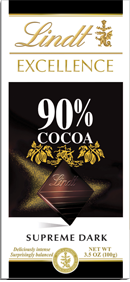
Dr. Mercola, the top-ranked health blogger, just posted a great piece about dark chocolate and health. (Long time readers will note that I linked back to Mercola.com because that’s what happy healthy bloggers do…) But Dr. Mercola’s generally on-target advice is missing a key piece of information this time. Read on to learn more.
I’m a big fan of chocolate’s health effects and blogged about it here a while back. Dr. Mercola writes about a new meta-analysis from Cambridge University’s Cardiovascular Epidemiology Unit, which evaluated 4,576 studies of chocolate involving 114,009 people, which determined:
Based on observational evidence, levels of chocolate consumption seem to be associated with a substantial reduction in the risk of cardiometabolic disorders.
The Bulletroof Diet – including carefully selected dark chocolate – already addresses cardiometabolic disorders, which include:
- Hypertension
- Elevated fasting glucose
- High cholesterol levels
- Abdominal obesity
- Elevated triglycerides
The chocolate study showed that people who ate the most chocolate had
- 37 percent reduction in cardiovascular disease, and
- 29 percent reduction in stroke
Higher Doses of Chocolate
Dr. Mercola is correct in advising people to eat very dark chocolate with low sugar and no additives like milk. In fact, I eat dark chocolate instead of a food bar, because chocolate has more healthy fat than any meal replacement bar I can find. It tastes better too.
However, he references a study recommending only 7 grams of dark chocolate per day. This seems conservative, considering the study I referenced in my earlier chocolate post showed 45 grams of quality chocolate every single day for eight weeks resulted in improved cholesterol levels without a single bad side effect.
Permission to be a Chocolate Snob: Avoiding Chocolate Toxins
But the dose isn’t where Dr. Mercola missed the mark. It’s all about the toxins. I write and speak extensively about mycotoxins. In fact, the Bulletproof Diet works better than Paleo because it accounts for mycotoxins in food selection.
Biotoxins including mycotoxins like aflatoxin form during cocoa production. Mishandled or insect-damaged cocoa beans get fungal growth during and after the process of fermentation. They continue to form during storage too.
According to the International Journal of Food Microbiology Vol. 125 (2008) the aspergillus flavus fungi that infects cocoa makes more toxins that just aflatoxin:
The present study reports on the natural mycobiota occurring in cocoa beans, paying special attention to the incidence of fungal species that are potential producers of mycotoxins. The results show that predominant fungi were different species of the genus Aspergillus belonging to section Flavi and Nigri. … Potential ability to produce aflatoxins (AFs) B1, B2, G1 and G2, cyclopiazonic acid (CPA)and ochratoxin A (OTA) was studied by isolate culture followed by HPLC analysis of these mycotoxins in the culture extracts. Results indicated that 64.1% and 34.2% of the A. flavus strains produced AFs and CPA, respectively. Most of the A. flavus strains presented moderate toxigenicity with mean levels of AFs ranging from 100 ng g?1 to 1000 ng g?1. All the CPA-producing strains of A. flavus were highly toxigenic producing N30 ?g g?1 of CPA. Furthermore, 98% of A. tamarii strains produced CPA and over 50% of them were highly CPA toxigenic. With respect to OTA-producing fungi, a high percentage of black aspergilli strains (49.2%) were able to produce OTA. Additionally, most of the OTA-producing isolates were of moderate toxigenicity, producing amounts of OTA from 10 ?g g?1 to 100 ?g g?1. These results indicate that there is a possible risk factor posed by AFs, CPA and OTA contamination of cocoa beans, and consequently, cocoa products.
The bottom line is that chocolate is a high risk food for mycotoxins. So then why do I eat it?
Because mold-free chocolate tastes great, is healthy, and makes you feel good. But it has to be mold-free. There is no way to be 100% certain that any chocolate is mold-free, but you can take some specific steps to find the good stuff, ensuring you get the healthy effects without the cancer and cardiovascular dangers of mycotoxins.
I recommend European chocolates because the mold standards in Europe are better than in the US. Lindt is the most consistently mold-free in my experience, and it’s affordable and widely available at most grocery stores. But even so, about 20% of the batches of Lindt I try seem to have mycotoxin problems. I can tell because a) I’m hyper-trained to be aware of my mental and physical state and b) I used to live in a house with toxic mold, so my immune system is primed to respond quickly.
You should buy a bar of Lindt 90% dark and try it on an empty stomach away from other foods. Watch how you feel – do you get joint pain, very dry mouth, stomach pain, or headaches? If so, that is not the batch for you. If you feel fine for the first hour or two, you’re probably eating good chocolate, and you can have more.
The 99% bar also has zero grams of sugar.
I highly recommend you store opened chocolate in the freezer or fridge, as the mold will continue to grow on opened bars of chocolate that sit out overnight.
I’ve researched ways to test chocolate for mold at home, and there isn’t a viable way to do it, yet. Give me some time and I’ll solve that too!
It’s time for me to enjoy some Bulletproof Coffee blended with a square of dark Lindt chocolate. Bulletproof Mocha…yum! In the meantime, give yourself permission to be a chocolate snob. Eat only the best you can find, and you’ll feel better, look better, and live longer. We live in an awesome world!












